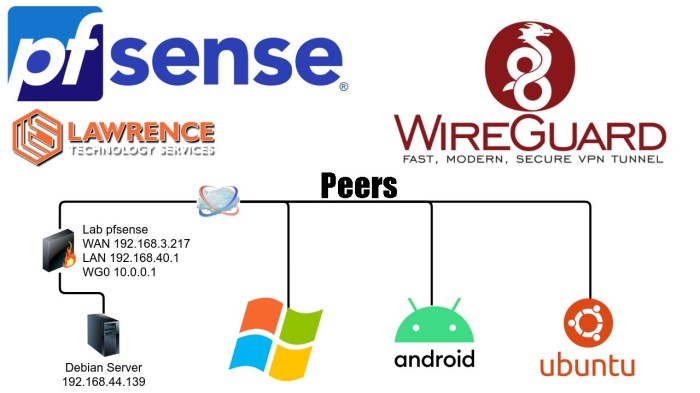In the realm of cybersecurity, virtual private networks (VPNs) have emerged as indispensable tools for protecting online privacy and enhancing security. Among the latest advancements in VPN technology, WireGuard stands out with its exceptional performance and ease of use. This article delves into the world of WireGuard split tunneling on Windows, exploring its benefits, configuration, troubleshooting, and various use cases.
WireGuard split tunneling offers a unique solution by allowing users to route specific traffic through the VPN tunnel while maintaining direct access to local network resources. This hybrid approach provides a balance between privacy and convenience, making it an ideal choice for users seeking both protection and seamless connectivity.
Introduction

WireGuard split tunneling is a technique that allows you to route specific traffic through a VPN while allowing other traffic to bypass the VPN. This can be useful for a variety of reasons, such as:
- Accessing local network resources while connected to a VPN.
- Improving performance for applications that don’t need to be routed through a VPN.
- Avoiding VPN blocks on certain websites or services.
Benefits of Using WireGuard Split Tunneling on Windows
There are several benefits to using WireGuard split tunneling on Windows, including:
- Improved performance: By only routing specific traffic through the VPN, you can improve performance for applications that don’t need to be routed through the VPN.
- Increased security: By only routing specific traffic through the VPN, you can reduce the risk of data breaches.
- Flexibility: You can customize WireGuard split tunneling to meet your specific needs.
How to Set Up WireGuard Split Tunneling on Windows
Step-by-Step Guide
-
- 1.
- *Install WireGuard on your Windows device. Download the latest WireGuard installer from the official website and run the installation wizard.
- 2.
- *Create a new WireGuard interface. Open the WireGuard application and click on the “Add Tunnel” button. Enter a name for your new interface and click “Create.”
- 3.
-*Configure the WireGuard interface. In the “General” tab, enter the following settings
-*Private Key
Generate a new private key or import an existing one.
-*Public Key
Enter the public key of the server you want to connect to.
-*Endpoint
Enter the IP address or domain name of the server.
-*Port
Enter the port number of the server.
-
- -*Allowed IPs
Enter the IP address or subnet of the devices you want to route through the WireGuard tunnel.
- 4.
- *Enable split tunneling. In the “Advanced” tab, check the box next to “Enable Split Tunneling.”This will allow you to specify which traffic you want to route through the WireGuard tunnel.
- 5.
- -*Allowed IPs
-*Add split tunneling rules. Click on the “Add Rule” button and enter the following settings
-*Source
Select the IP address or subnet of the devices you want to route through the WireGuard tunnel.
-*Destination
Select the IP address or subnet of the devices you want to route through the WireGuard tunnel.
-*Protocol
Select the protocol you want to route through the WireGuard tunnel (e.g., TCP, UDP).
-
- -*Port
Select the port number you want to route through the WireGuard tunnel.
- 6.
- *Activate the WireGuard interface. Click on the “Activate” button to start the WireGuard interface.
- 7.
- -*Port
-*Verify split tunneling.
Open a command prompt and run the following command
“`netsh interface show interface“`You should see the WireGuard interface listed with the “Split Tunneling” column set to “Enabled.”
Advanced Configuration Options
WireGuard split tunneling on Windows offers advanced configuration options that allow you to customize its behavior and tailor it to your specific requirements.
These options can be accessed by editing the WireGuard configuration file, which is typically located at C:\Program Files\WireGuard\wg0.conf .
Customizing Allowed Traffic
By default, WireGuard split tunneling only allows traffic destined for the remote network to pass through the tunnel. However, you can modify this behavior by specifying additional allowed traffic using the AllowedIPs option.
For example, to allow all traffic from your local network to pass through the tunnel, you can add the following line to your configuration file:
AllowedIPs = 192.168.1.0/24
You can also specify multiple allowed IP ranges or individual IP addresses.
Excluding Specific Traffic
In some cases, you may want to exclude certain types of traffic from passing through the WireGuard tunnel. This can be achieved using the ExcludedIPs option.
For instance, to exclude traffic destined for a specific IP address, you can add the following line to your configuration file:
ExcludedIPs = 10.0.0.1
You can also use the ExcludedIPs option to exclude traffic based on port numbers or IP ranges.
Modifying MTU Settings
The MTU (Maximum Transmission Unit) setting determines the maximum size of data packets that can be sent through the WireGuard tunnel. The default MTU for WireGuard is 1420 bytes, but you can adjust this value to optimize performance for your specific network.
To modify the MTU setting, add the following line to your configuration file:
MTU = 1500
Increasing the MTU can improve performance for large file transfers or high-bandwidth applications, but it may also increase the likelihood of packet fragmentation.
Troubleshooting WireGuard Split Tunneling on Windows

WireGuard split tunneling on Windows can occasionally encounter issues. Here are some common problems and their solutions:
Ensure that your WireGuard configuration is correct and that you have followed the setup instructions carefully.
If you encounter any problems, check the following:
Connection Issues
- Check if the WireGuard interface is active and has an IP address assigned to it.
- Verify that the firewall is not blocking WireGuard traffic.
- Ensure that the WireGuard server is reachable and is listening on the correct port.
DNS Resolution Issues
- Check if the DNS settings are configured correctly in the WireGuard interface.
- Try using a different DNS server.
- Ensure that the DNS server is reachable and is not blocking WireGuard traffic.
Performance Issues
- Check if the network adapter is capable of handling the speed of the WireGuard connection.
- Try using a different network adapter.
- Ensure that the WireGuard server has sufficient resources to handle the traffic.
Other Issues
- Check if the WireGuard client is up to date.
- Try restarting the WireGuard client.
- Check the WireGuard logs for any error messages.
Performance Considerations

WireGuard split tunneling on Windows generally has minimal impact on performance, but certain factors can affect its efficiency.
To optimize performance, consider the following tips:
Network Speed
The speed of your internet connection can impact WireGuard’s performance. Ensure you have a stable and fast connection to minimize latency and maximize throughput.
CPU Usage
WireGuard is a lightweight protocol, but it still requires some CPU resources. If you have a low-powered device, it’s advisable to disable unnecessary features, such as logging, to reduce CPU usage.
Packet Size
The size of packets sent through WireGuard can affect performance. Larger packets may require more processing time and introduce latency. Consider adjusting the MTU (Maximum Transmission Unit) size to optimize packet size for your network.
Number of Tunnels
Running multiple WireGuard tunnels simultaneously can increase CPU and memory usage. If you don’t need to use multiple tunnels, consider disabling any unnecessary ones.
Security Considerations
WireGuard split tunneling on Windows offers convenience, but it also introduces security implications that need to be addressed.When using split tunneling, only specific traffic is routed through the VPN, while other traffic continues to use the regular internet connection. This can create a potential security risk, as unencrypted traffic can be vulnerable to eavesdropping and other attacks.To
mitigate these risks, it’s essential to implement additional security measures, such as:
Encryption
Strong encryption is crucial to protect sensitive data from unauthorized access. Ensure that the VPN connection uses a robust encryption algorithm, such as AES-256 or ChaCha20.
Firewall
A firewall can help prevent unauthorized access to the system by blocking incoming connections from untrusted sources. Configure the firewall to allow only necessary traffic through the VPN connection.
Regular Updates
Keep the VPN software and operating system up-to-date with the latest security patches. These updates often include fixes for security vulnerabilities that could be exploited by attackers.
User Education
Educate users about the risks associated with split tunneling and how to use it securely. Encourage them to only access trusted websites and services when using the regular internet connection.By implementing these measures, you can enhance the security of your system while utilizing the benefits of WireGuard split tunneling on Windows.
Comparison with Other VPN Technologies
WireGuard split tunneling is a relatively new technology, and it offers several advantages over other VPN technologies, such as OpenVPN and IPsec.WireGuard is much faster than OpenVPN and IPsec. This is because WireGuard uses a more modern encryption algorithm, and it does not require any additional software to be installed.WireGuard
is also more secure than OpenVPN and IPsec. This is because WireGuard uses a more modern encryption algorithm, and it does not have any known security vulnerabilities.Finally, WireGuard is easier to configure than OpenVPN and IPsec. This is because WireGuard uses a simple configuration file, and it does not require any advanced networking knowledge to set up.
OpenVPN
OpenVPN is a popular VPN technology that has been around for many years. OpenVPN is known for its security and reliability, but it is also relatively slow and difficult to configure.
IPsec
IPsec is a VPN technology that is used by many businesses and governments. IPsec is very secure, but it is also very complex to configure.
Use Cases for WireGuard Split Tunneling
WireGuard split tunneling offers various benefits in different scenarios:
Secure Remote Access
* WireGuard split tunneling allows remote employees to securely access corporate resources while maintaining local internet access.
It prevents sensitive corporate data from being exposed to untrusted networks, enhancing security and reducing the risk of data breaches.
Enhanced Performance
* By routing only specific traffic through the VPN, split tunneling reduces bandwidth consumption and improves internet speed for non-VPN traffic.
This is particularly beneficial for activities like video conferencing, gaming, or streaming media, which require high bandwidth.
Granular Control
* Split tunneling provides granular control over which traffic goes through the VPN and which traffic remains on the local network.
This flexibility allows users to customize their VPN experience based on their specific needs and security requirements.
Cost Optimization
* By reducing the amount of traffic routed through the VPN, split tunneling can help reduce VPN costs.
This is especially advantageous for organizations with large numbers of remote users or those using expensive VPN services.
Improved User Experience
* Split tunneling eliminates the need for users to constantly switch between VPN and non-VPN connections.
This provides a seamless and convenient user experience, enhancing productivity and satisfaction.
Resources
To further enhance your understanding of WireGuard split tunneling on Windows, explore the following resources:
These articles, tutorials, and documentation provide valuable insights and practical guidance on configuring, troubleshooting, and utilizing this feature.
Articles and Tutorials
- WireGuard Split Tunneling on Windows: A Comprehensive Guide
- How to Set Up WireGuard Split Tunneling on Windows 10 and 11
- Troubleshooting WireGuard Split Tunneling on Windows
Documentation
- WireGuard Split Tunneling for Windows: Official Documentation
- Microsoft Windows Networking Documentation
Conclusion
WireGuard split tunneling on Windows offers several advantages, including improved performance, reduced latency, and increased security. However, it may not be suitable for all users. For users who require complete protection of their online traffic, a full VPN tunnel may be a better option.
Overall, WireGuard split tunneling on Windows is a powerful tool that can enhance the security and performance of your VPN connection. If you are looking for a way to improve your online privacy and security without sacrificing performance, WireGuard split tunneling is a great option.
Recommendation
Whether or not to use WireGuard split tunneling on Windows depends on your individual needs and requirements. If you are looking for a way to improve the performance and security of your VPN connection, WireGuard split tunneling is a great option.
However, if you require complete protection of your online traffic, a full VPN tunnel may be a better choice.
Last Point
In conclusion, WireGuard split tunneling on Windows offers a compelling combination of security, performance, and flexibility. By leveraging this technology, users can safeguard their online activities, access geo-restricted content, and optimize network performance. Whether you’re a seasoned cybersecurity professional or simply seeking enhanced privacy, WireGuard split tunneling is an invaluable tool that empowers you to navigate the digital landscape with confidence and control.